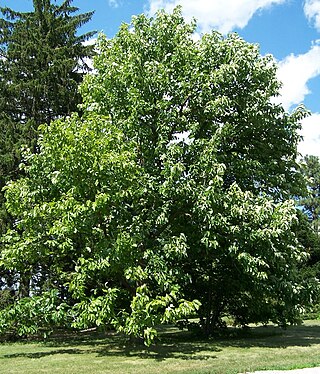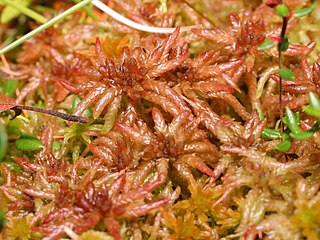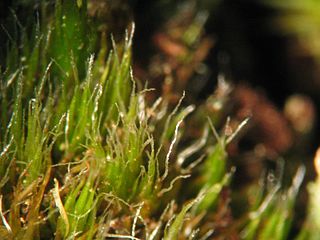
Alopecurus pratensis, known as the meadow foxtail or the field meadow foxtail, is a perennial grass belonging to the grass family (Poaceae). It is native to Europe and Asia.

Magnolia acuminata, commonly called the cucumber tree, cucumber magnolia or blue magnolia, is one of the largest magnolias, and one of the cold-hardiest. It is a large forest tree of the Eastern United States and Southern Ontario in Canada. It is a tree that tends to occur singly as scattered specimens, rather than in groves.

Puccinia dioicae is a plant pathogen that causes rust on goldenrod.
Tayloria lingulata, commonly known as lingulate dung moss, tongue-leaved gland-moss, or marsh collar-moss, is a moss found in montane habitats in the Northern Hemisphere including Europe, Asia and North America.

Sphagnum magellanicum, commonly called Magellanic bogmoss, Magellan's sphagnum, Magellan's peatmoss or midway peat moss, is a widespread species of moss found in wet boreal forest in the far south and southwest of South America, North America and Eurasia.

Campylopus introflexus, also known as the heath star moss, is a species of moss. The first description of the species was made by Johannes Hedwig as Dicranum introflexum in 1801.

Campanula uniflora, known commonly as arctic bellflower and arctic harebell, is a short and slender rhizomatous perennial in the bellflower family Campanulaceae. It is distributed in arctic North America, including the Rocky Mountains and Greenland, in the Asian part of Beringia and in Iceland, Svalbard, the Scandes Mountains and Novaja Zemlja.

Kalmia procumbens, commonly known as alpine azalea or trailing azalea, is a dwarf shrub of high mountain regions of the Northern Hemisphere that usually grows no more than 10 centimeters (4 in) tall. Originally named by Linnaeus as Azalea procumbens, it is also named after French botanist L.L.A. Loiseleur-Deslongchamps - Loiseleuria procumbens.

Tayloria is a genus of mosses in the family Splachnaceae. It comprises 45 species, divided among 6 subgenera:

Splachnum sphaericum, also known as pinkstink dung moss, is a species of moss. This species occurs in North America. It also occurs in upland Britain, where it is known as round-fruited collar-moss and in north temperate and boreal regions of Europe. Its habitat is bog and wet heathland where it grows on herbivore dung. This and other Splachnum species are entomophilous. The sporophytes, which are generally coloured red or black, produce an odour of carrion that is attractive to flies and the spores are dispersed by flies to fresh dung.

Saxifraga hirculus is a species of saxifrage, commonly called marsh saxifrage, yellow marsh saxifrage, or bog saxifrage. It is a perennial herb with yellow flowers and red stem, 5–30 cm high, found on bog landscape.
Tayloria nepalensis is an extant dung moss species found in Nepal. It was first described by Zennoske Iwatsuki and William Campbell Steere in 1975.
Phaeosaccion is a genus of algae with monostromatic tubular to saccate thalli, up to 20 centimetres (7.9 in) long and to 2 centimetres (0.79 in) wide. It is the sole genus in the family Phaeosaccionaceae. It is olive brown and resembles young plants of Scytosiphon. The sole species in the genus is Phaeosaccion collinsii, a species of marine algae. It was first identified in a publication by W.G. Farlow in the article Notes on New England algae published in Bulletin of the Torrey Botanical Club in 1882. It was named in honor of Frank Shipley Collins. Phaeosacchion collinsii is red listed in Iceland as a vulnerable species (VU).

Splachnaceae is a family of mosses, containing around 70 species in 6 genera. Around half of those species are entomophilous, using insects to disperse their spores, a characteristic found in no other seedless land plants.

Carex capillaris, the hair-like sedge, is a species of sedge found in North America and northern Eurasia including Greenland.
Atrichum angustatum is a species of mosses belonging to the family Polytrichaceae.
Gyroweisia tenuis, the Slender Stubble-moss, is a species of moss belonging to the family Pottiaceae.
Neckera crispa is a species of moss belonging to the family Neckeraceae.

Splachnum rubrum, is a species of moss in the Splachnum genus which is found in the Northern Hemisphere. Like other species in the Splachnum genus, it is known for growing on animal waste and being entomophilous. Although very rare, its bright red-purple sporangia makes its sporophyte stage stand out well when seenin the wild.











